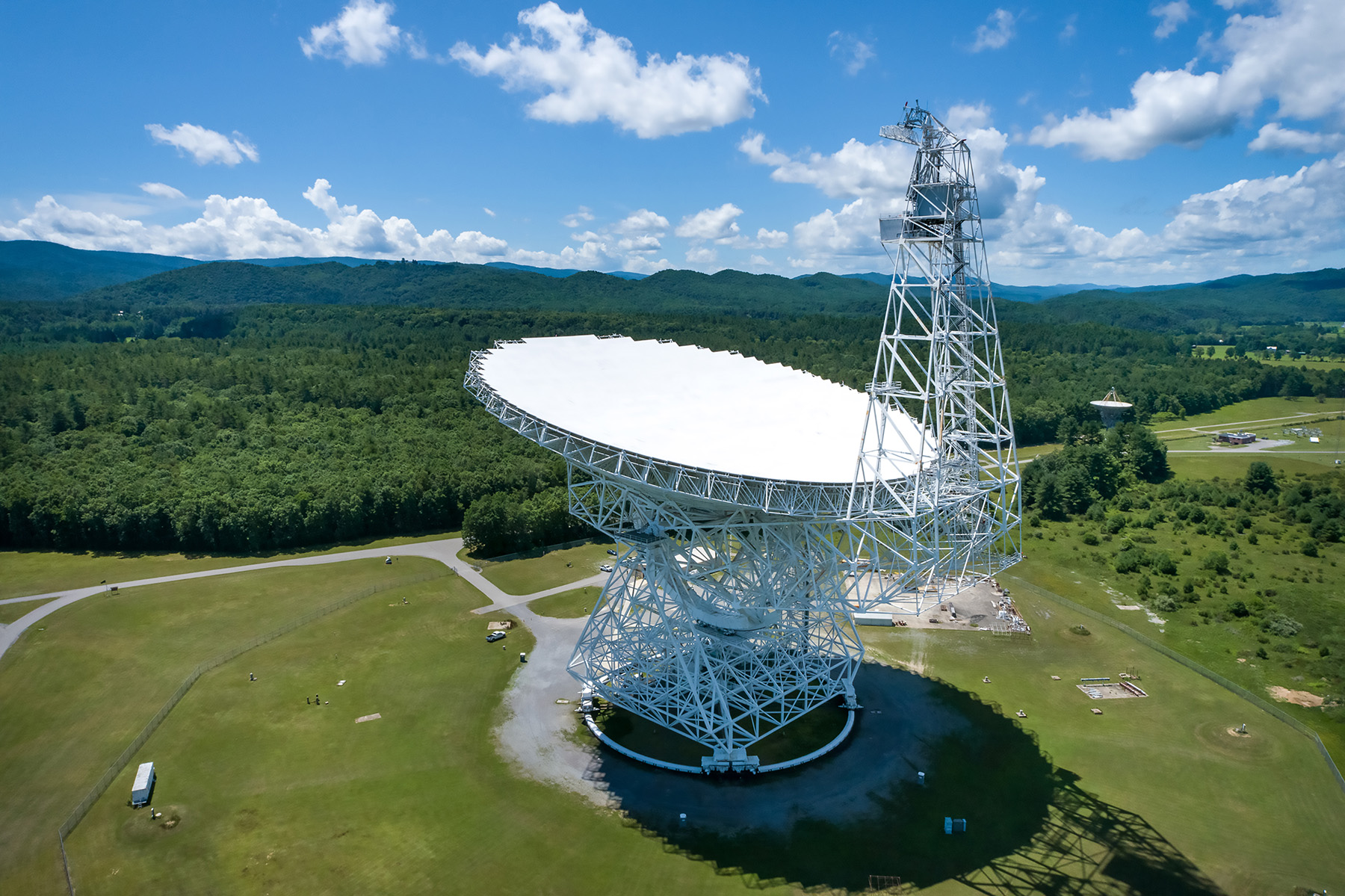
By Robert L. Reid
Rising within a protected area of West Virginia, the Robert C. Byrd Green Bank Telescope towers over its surroundings so scientists can study the stars. For the engineers who regularly inspect this behemoth, the work often involves climbing and rappelling on ropes, and the experience can be both familiar and surprising.
The great radio telescope reaches more than 400 ft into the sky, towering above the grassy fields on which it stands in Green Bank, West Virginia. Its enormous parabolic reflector dish — more than 300 ft across — reaches out even farther, metaphorically, at least, probing the heavens, listening to the noise of the universe: the radio waves that scientists use to study the energy output of stars. The telescope can also help map asteroids, moons, planets, and comets; detect warps in the fabric of space; analyze the chemical building blocks of the solar system; and help study the history and future of galaxies.
Owned by the National Science Foundation, the $75 million Robert C. Byrd Green Bank Telescope is the world’s largest fully steerable radio telescope and one of several such astronomical instruments in Green Bank operated by the NSF’s National Radio Astronomy Observatory and Associated Universities Inc., a nonprofit scientific facilities management organization.
Framed in more than 1,300 individual steel elements — some as thin as 5/64 in., others forming components 8 ft in diameter — the telescope is a massive structure that seems to defy gravity. Weighing more than 17 million lb, it can rotate a full 360 degrees on its base, with 16 motorized wheels turning the structure around a 210 ft diameter track. Other motors tilt the enormous reflector dish forward and back over a 90-degree range, bringing the edge of the dish to within 20 ft of the ground. Together, the rotation and tilting features enable the telescope to track objects across almost the entire sky, excepting just the first few degrees above the horizon.
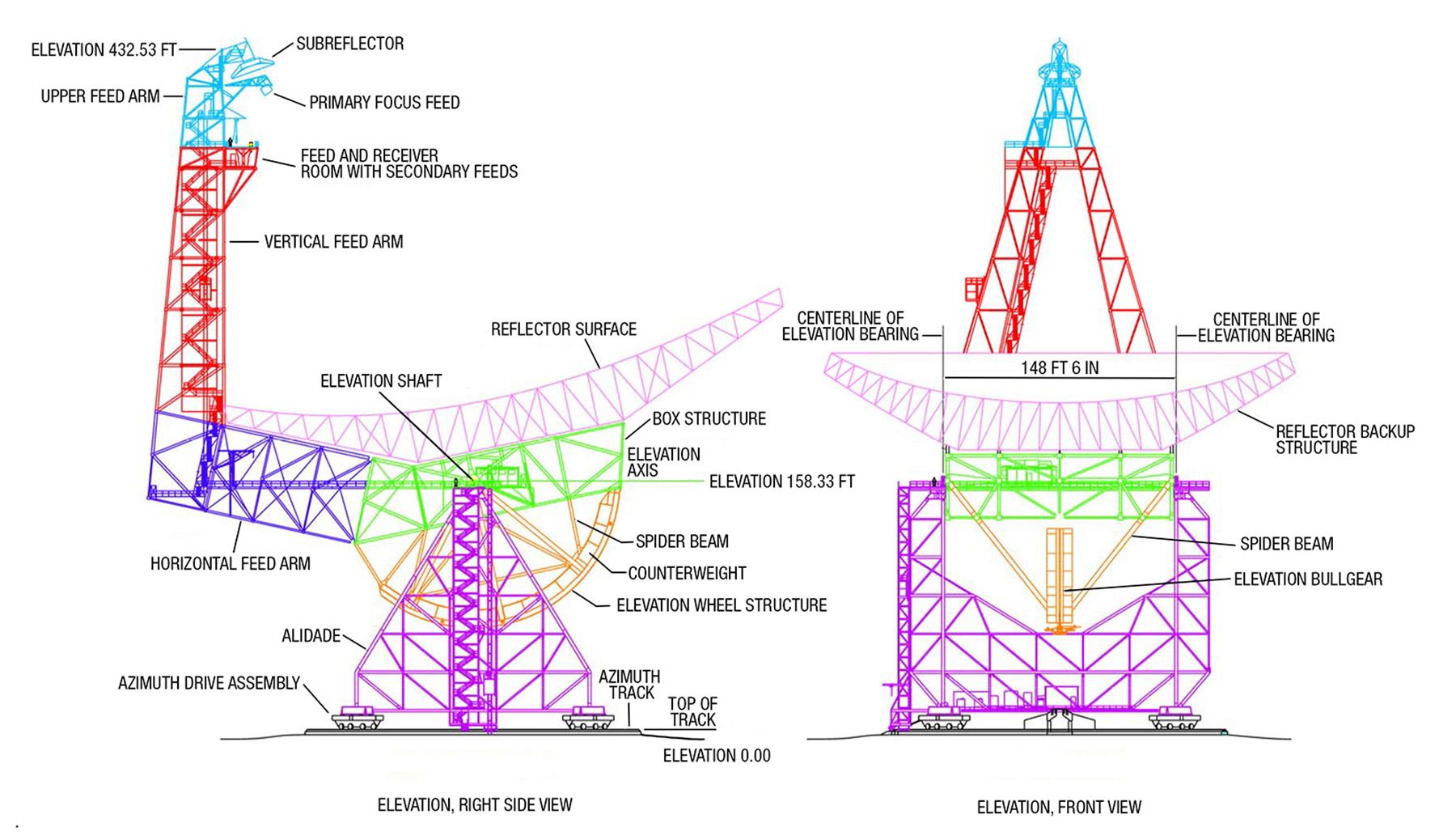
At the same time, the telescope is not immune to the laws of physics that it helps scientists study. Despite its massive size, it is also potentially fragile. The current telescope was completed in 2000, following the collapse in November 1988 of its slightly smaller predecessor when a key gusset plate in a critical box girder assembly on that structure failed, reducing what had once been one of the world’s largest radio telescopes to a giant pile of twisted, bent steel.
The loss of the earlier telescope “was attributed to a lack of inspection and maintenance,” explains the website of Modjeski and Masters, a Mechanicsburg, Pennsylvania-based engineering firm with a long history of inspecting large structures such as bridges. So to help the new telescope “avoid the same fate as its predecessor,” the NRAO contracted with Modjeski and Masters to develop an inspection plan and procedures for the Robert C. Byrd telescope. The NRAO’s staff inspects the smaller telescopes at Green Bank.
One of the designers of the new telescope was Peter Keating, Ph.D., P.E., an assistant professor of civil engineering at Texas A&M University and a former Modjeski and Masters engineer who understood the importance of regular inspections, explains Mike Januszkiewicz, P.E., SPRAT III, the assistant director of field services in the Poughkeepsie, New York, office of Modjeski and Masters.
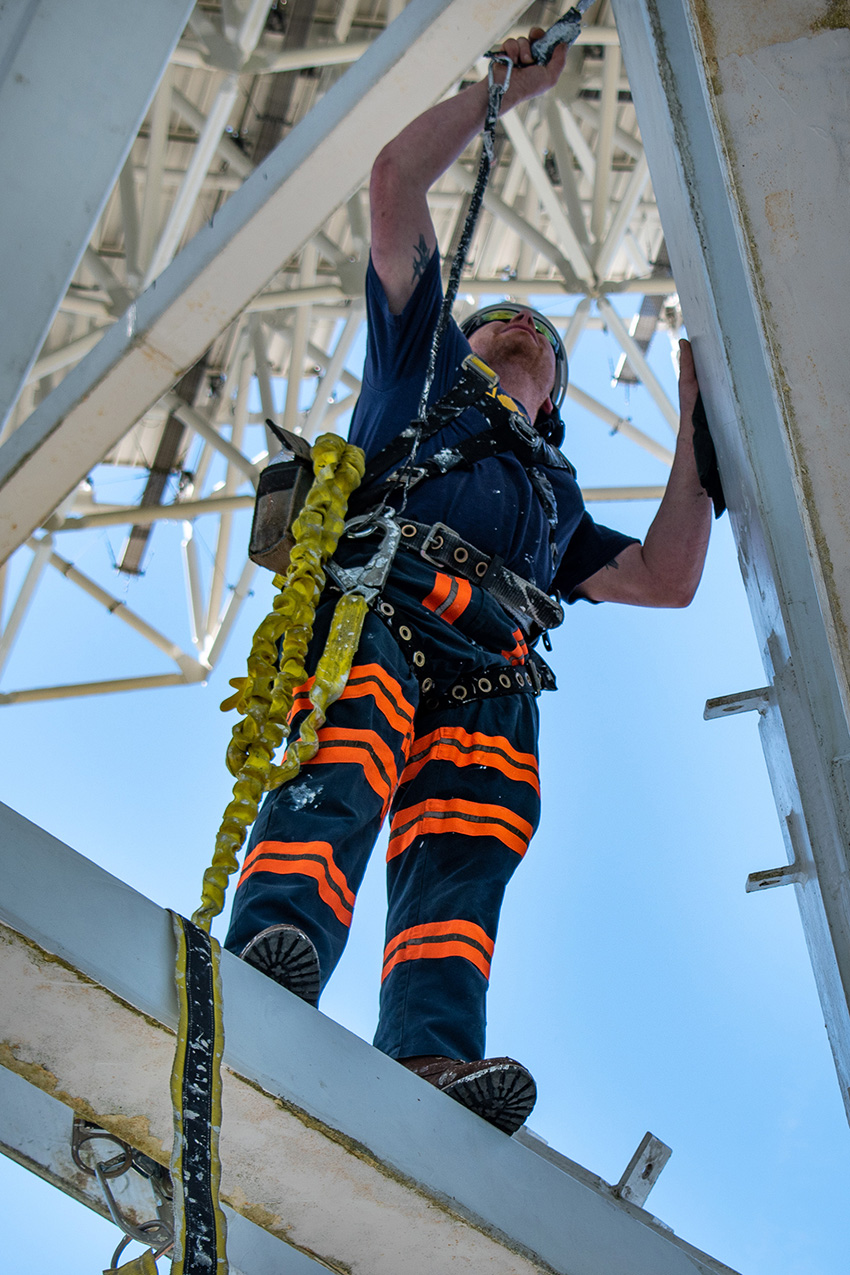
Keating brought Modjeski and Masters into the project, first to help create a detailed database of all the structural members and joints, based in part on a finite element model of the new telescope. Starting in 2003, the firm also conducted seven lengthy and challenging inspections of the telescope, each lasting between seven and nine weeks and involving roughly four inspectors on the telescope at a time and one person on the ground assisting them and inputting the information collected into that database, says Januszkiewicz.
Inspecting key components
The telescope structure features a series of steel trusses that support the key components that the Modjeski and Masters team inspects at regularly scheduled periods, generally once every three years. Among the most significant of these components are:
- The alidade, or base, of the telescope, which features the motors and wheels that rotate the structure.
- The box structure, which includes the frame for the tilting structure and the 8 ft diameter elevation shaft that provides the primary support for the telescope’s tipping capability.
- The feed arms, which cantilever vertically off the box structure to support the signal receiver — the highest point on the structure, some 480 ft off the ground.
- The reflector backup structure, which features a frame of thin tubular members supporting the telescope’s dish; the backup structure is inspected during alternate visits, one-half at a time.
- The elevation wheel structure, which includes the spider beams that support the box structure and transfer loads into the elevation shaft. This is also where the massive concrete-filled counterweight needed to balance the tilting structure is located.
Although the inspection teams do not examine the dish itself — which is covered in thousands of aluminum panels controlled by actuator motors to maintain the proper shape under changing environmental conditions and gravitational loading — they sometimes do cross portions of the dish surface to reach other locations on the telescope, Januszkiewicz notes.
Training the team
During inspections, the engineers sometimes use a 158 ft tall aerial work platform to access certain portions of the telescope, especially when the dish receiver is tilted closer to the ground. But primarily they rely on the specialized skills of rope access work — using combinations of ropes, straps, and safety lines as well as various ascender and descender tools to rappel, climb up, or slide along the telescope’s structural members.
Modjeski and Masters was well positioned to start the inspections, given that the firm had long used rope access systems to conduct bridge inspections and in 2000 had established a formal technical and rope access program for the company’s engineers, notes Januszkiewicz, who coordinates the program.
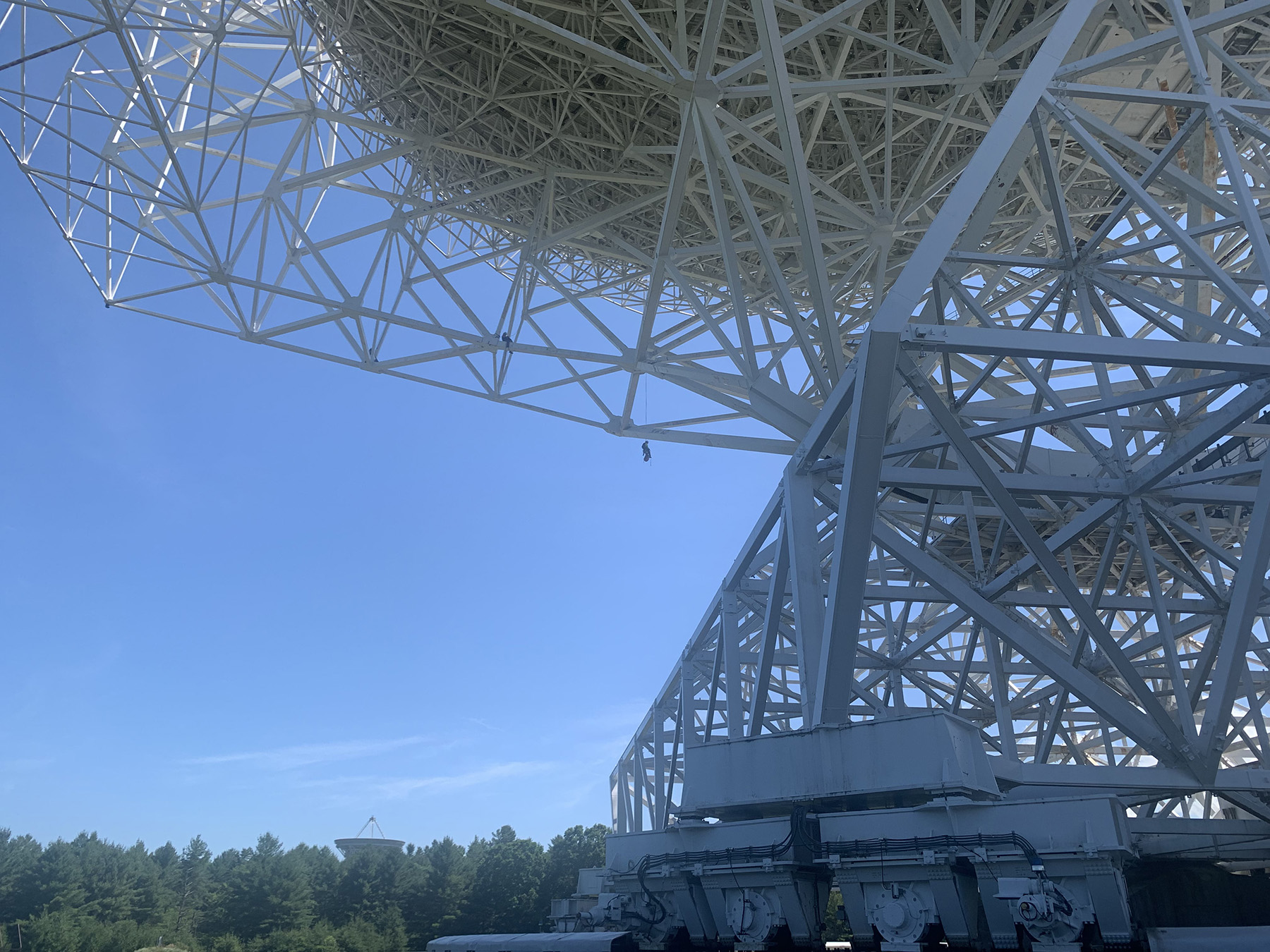
Although Januszkiewicz says he is a recreational mountain climber, most of the 21 men and women in the program are not. All participants do have “experience at height,” however, which generally means they have worked on bridge inspections, suspended under bridge structures 100 ft or more above roads or rivers. To join the program, employees also need to have worked for Modjeski and Masters for at least one year and must successfully complete a weeklong training course. This is followed by evaluations, which include written and oral tests that cover the equipment required for rope access work and safety issues and a demonstration of the practical skills.
Although there are no age, height, or weight restrictions per se — Januszkiewicz is 60 years old — there are fitness requirements that can quickly weed people out of the program. “The training is intensive,” says Januszkiewicz, who serves as an evaluator. “So I guarantee that, no matter how good of shape you’re in, by the end of that week, you’re gonna be sore!”
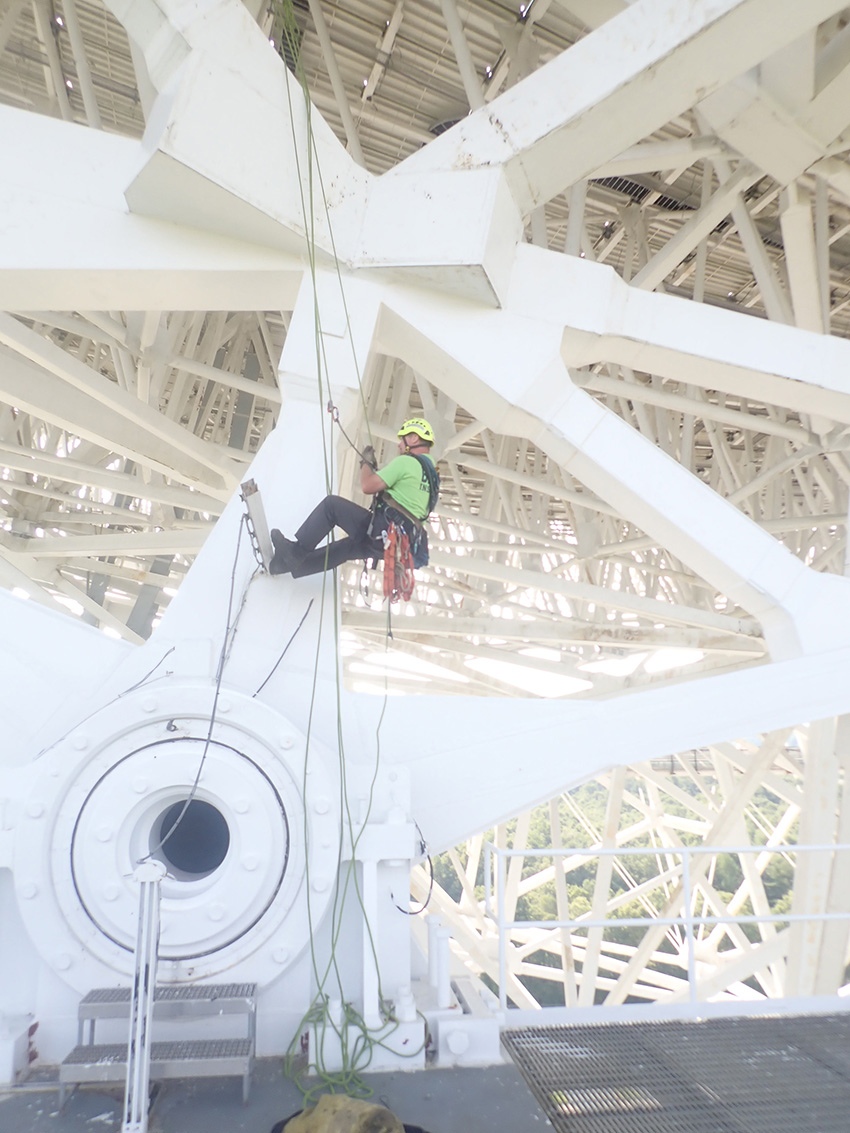
Although the vast majority of Modjeski and Masters’ inspectors in the rope access program are engineers, there are a few technicians who are highly trained in specialties such as the inspection of coatings or the use of specialized nondestructive testing equipment, Januszkiewicz says. Only one technician has participated in any of the Green Bank inspections.
Modjeski and Masters offers an in-house certification program for its rope access participants with an annual training requirement. Several of the program’s participants are also accredited by the Society of Professional Rope Access Technicians; Januszkiewicz, for example, holds the highest certification level, SPRAT III.
Getting into place
Among the challenges of working on the Robert C. Byrd telescope is simply getting into position to conduct the inspection. This can take as much as half an hour and involve riding the telescope’s elevator, climbing ladders and stairs into the maze of steelwork, and then hooking up the rope systems and their accoutrements to the various structural members before the inspection even starts, notes Januszkiewicz.
The inspection team members sometimes work individually, sometimes in pairs — some rope access systems require a second person to help monitor the inspector’s movements. Standard equipment for inspectors includes helmets, gloves, and harnesses with integrated ascender and descender devices as well as lanyards with foot loop systems that allow the inspectors to employ their legs to help them climb, Januszkiewicz explains.
Among the most common tools the inspectors take up onto the telescope with them are digital cameras, which are tethered around their necks, making it nearly impossible for the inspectors to drop the cameras. They also use scrapers to examine possible corrosion rather than the hammers they might use on bridge inspections because the steel is quite thin on many of the telescope structural members. Tape measures, stick rules, pit gauges, flashlights, and radios are also commonly carried up by the inspectors.
If an inspector needs some tool out of the ordinary — such as a special device for nondestructive testing — he or she can contact the ground person via radio to have the tool brought out to the structure. Depending on where the inspector is on the telescope at that time, he or she “may meet at a designated location on the structure, or the ground person may move to a location (via the elevator or ladders and stairs) where (he or she) can lower or pass the equipment to an individual,” Januszkiewicz says.
Staying quiet
Inspections are conducted during the summer months at times when the telescope is shut down during the day for maintenance. But even if the Robert C. Byrd telescope is not in use during inspections, the Green Bank staff might be using other telescopes at that time. So the radios the inspectors carry must be set to specific frequencies that will not disturb the scientific work going on. In fact, the Green Bank radio telescopes are so sensitive to radio frequency interference that they are located within a protected area known as the National Radio Quiet Zone that extends for a roughly 50 mi radius around the site.
The zone was established in 1958 by the Federal Communications Commission to shield the telescopes from any potential radio interference, including that caused by power lines, radio stations, cellphones, and even the radio emissions from spark plugs or computer chips in modern gasoline-powered vehicles. That is why all vehicles used on-site are diesel powered, including some 50-year-old trucks and former taxis.
Microwave ovens must be housed within shielded boxes, Januszkiewicz adds, and a hotel the team used to stay in did not have phones in the rooms. There was just one phone booth out in the parking lot. “We had to line up to make calls,” he says. During more recent inspections, the team has rented a house owned by the NRAO.
Valuing engineers
Perhaps the most important thing the inspectors take up into the telescope with them during inspections is their own knowledge of structural engineering. “I can teach a lot of people how to climb,” says Januszkiewicz. “It’s a lot harder to teach someone how to really, fully understand the structure and how it works and where to be looking” to find potential problems and how important those problems might be, he explains.
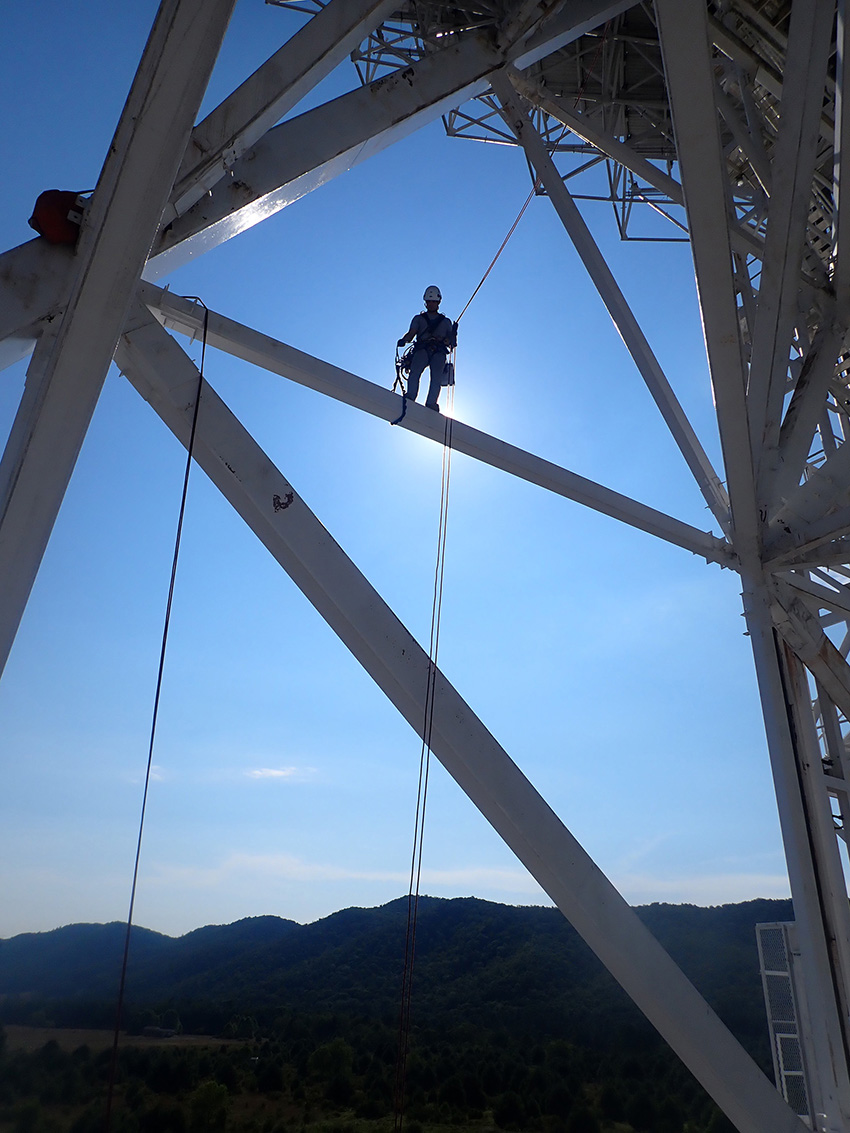
So having a team whose members understand the structure — who know, for instance, that a problem in the web of a beam near the end of the span at a point of high shear is far more critical than one in the middle of the span — is vital; that is the advantage of having so many engineers performing the inspections, says Januszkiewicz.
As the inspectors move about the telescope, they examine the structural members and joints in four critical areas: welds, caulking, structure, and paint or coatings. They then use a four-point criticality rating system to record the current conditions in the aforementioned database, with 1 meaning the part examined is in perfect condition and 4 representing the worst conditions. The NRAO maintenance teams can then use this rating system to generate reports and prioritize work on, for example, any structural element rated 3 or 4, Januszkiewicz says. The goal, he explains, is to find problems early so that “the little things don’t become big things.”
For example, the telescope features a great number of welds because many of the structural elements were first bolted together and then welded so that the bolts could be removed to reduce the overall weight of the structure. “When you do that, though, you now have a whole lot of welds,” Januszkiewicz says, making the structure very sensitive to fatigue.
A weld with no visible defects will be rated 1, according to a Modjeski and Masters presentation on the inspection program. If it features an “abnormal weld profile, minor crater, minor overlap, or minor porosity,” it will be rated 2. If there are cracks or suspected cracks in a weld or the adjacent base metal of a structural member in a noncritical location, the weld will be given a rating of 3. A crack or suspected crack in a critical member will receive a rating of 4, and immediate corrective measures will be triggered.
The same approach and rating system are employed for the caulking that is used to fill in a gap where two members do not fully meet. Inspectors look for any failure in the caulking that could permit water ingress and lead to corrosion inside the structural member. Likewise, the inspectors examine the members for structural deficiencies, ranging from minor misalignments, gouges, or other minor surface defects “not affecting structural capacity” up to “serious misalignment or other structural defect (crack, stress lines, significant section loss, or defective fasteners)” that may affect structural capacity, according to the Modjeski and Masters presentation.
The typical deficiencies encountered related to the paint or coatings include slight evidence of corrosion; minor freckling, chalking, and/or blistering of the top coating but without metal exposed; a freckled surface with rust prevalent and exposed metal but no section loss; and a failure of the coating system, resulting in surface pitting and measurable section loss.
Although Januszkiewicz likes to record his findings using pencil and paper, the younger inspectors tend to use computer notepads that enable them to call up technical drawings with which they can just “tap on a member, and the details of members and joints load up” for them to see, he explains.
Staying safe, staying straight
Although the engineers generally arrive on-site by about 6 a.m. on inspection days, there can be delays of an hour or more before they actually start work. That’s because a heavy fog rolls in most mornings, which leads to condensation that can make the telescope’s steel too slippery to safely work on. Once the structure dries, the team then usually spends half a day up in the framework, comes down for lunch, and then goes back up into the telescope for the rest of the day.
While working within the telescope’s framing, the inspectors might encounter any number of other living creatures, including black widow spiders (which are prevalent in that part of West Virginia) and sometimes even small animals like raccoons that “come out to explore the structure — 200 ft in the air,” Januszkiewicz says.
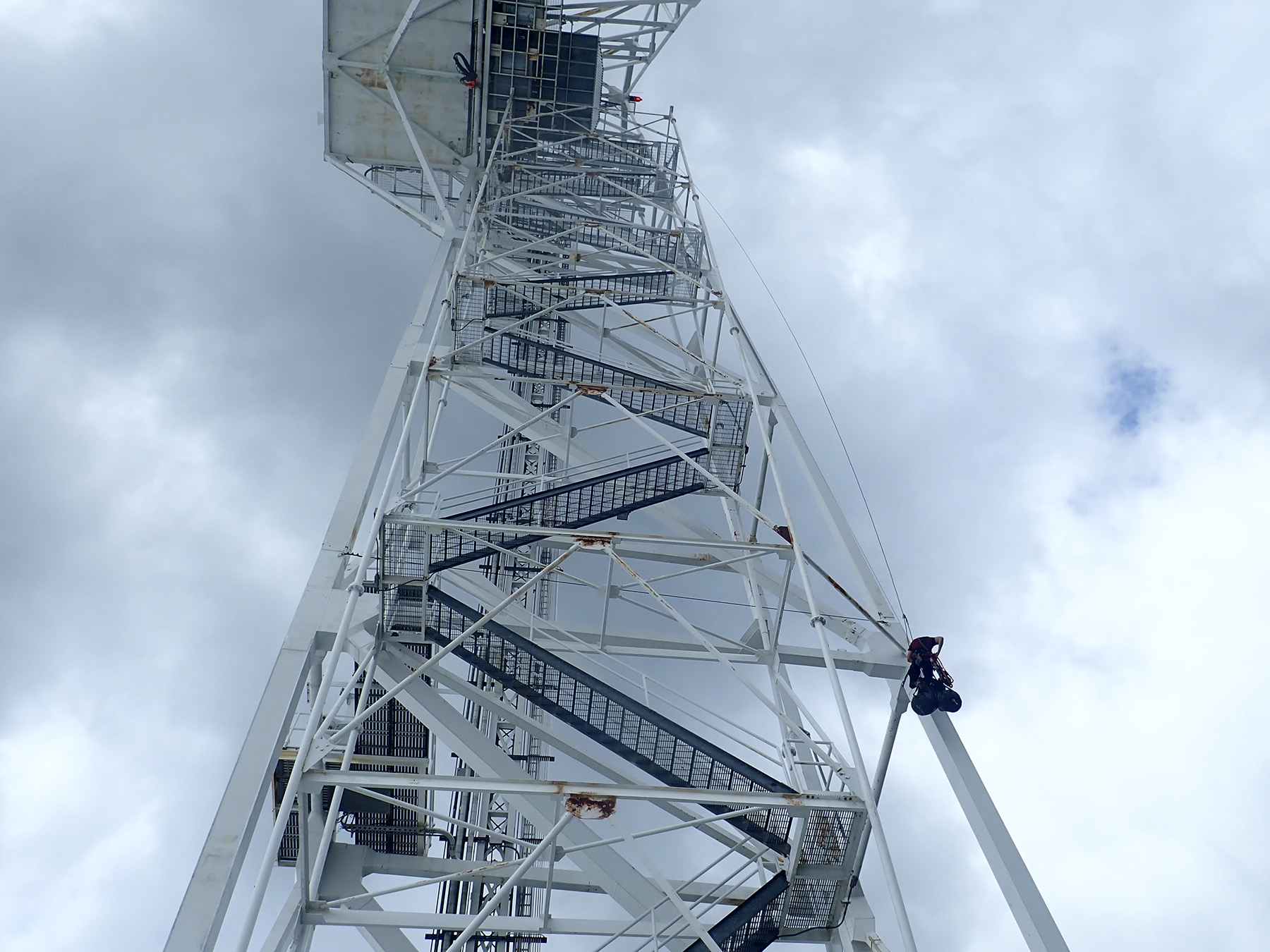
Larger animals, including deer and bears, are sometimes seen wandering around the base of the telescope. Fortunately, a fence protects the base from unwanted visitors getting too close to the structure, so no inspectors have ever been stuck up in the steel by the presence of a predator on the ground. And if, say, a bear sticks around too long, an NRAO staff member can drive by on an all-terrain vehicle and shoo it away.
Because the Robert C. Byrd telescope consists primarily of a giant series of trusses, much of the inspection work involves things familiar to the engineers. “It’s just a matter of using our expertise of structures and how they perform,” Januszkiewicz notes. What’s not familiar, though, are the many odd or confusing angles at which different structural elements connect to one another on the telescope — which can make it a challenge for an inspector to stay properly oriented.
“When you get up in a structure like that, you can lose track of the horizon,” explains Januszkiewicz. “You can be standing there and feel your right leg getting really tired. So you lean a little to your left — and then realize you had previously been leaning way to the right. But because all the steel was tilted that way, you thought you were standing straight. Your brain tricks you as to what’s straight up and down and what’s horizontal.”
So it seems the telescope itself can be as surprising as the stars it studies.
Robert L. Reid is the senior editor and features manager of Civil Engineering.
This article first appeared in the July/August 2022 issue of Civil Engineering as “Inspecting Green Bank.”



